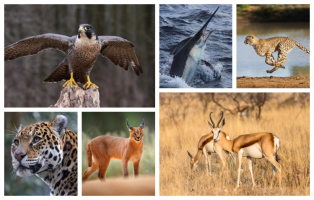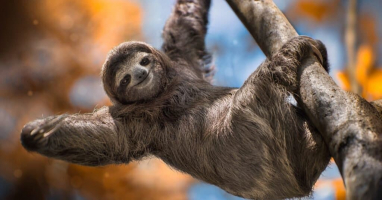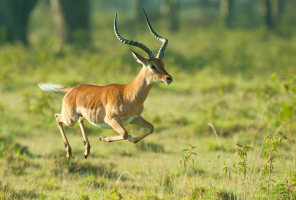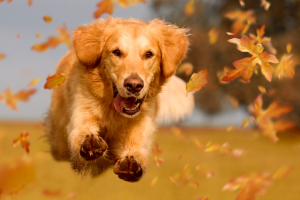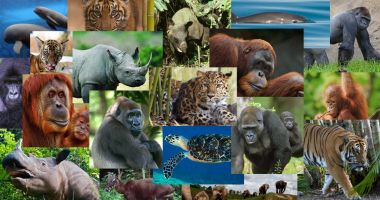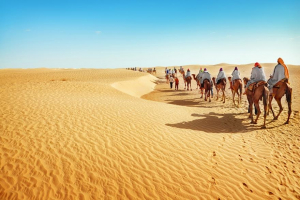Top 10 Largest Horned Animals In The World
Some animals have acquired horns, which are one of the most conspicuous and spectacular adaptations in the animal kingdom. Cows, goats, buffalo, antelope, ... read more...rhinos, and deer are among the animals that develop horns. Horns are available in a variety of forms and sizes, ranging from small and straight to long and twisted. Having said that, which animals have the world's largest horns? This article will mention the largest horned animals in the world.
-
The Asian water buffalo has the largest horns of all the animals on the planet. These domestic bovines, sometimes known as water buffalo, originated in India and Southeast Asia. They are now one of the most common buffalo species, with over 130 million living throughout the world. There are two varieties of buffalo: the river buffalo, which is leaner and taller, and the swamp buffalo, which is stockier.
Depending on their age and subspecies, their skin can range from black to blue to gray. They range in height from 47 to 63 inches and weigh between 660 and 2,400 pounds. The horns of Asian water buffalos grow outward and bend into a semicircle. Many of them are up to 10 feet long from point to point and 60 inches wide. However, a bull shot in 1955 holds the Guinness record for longest horns, with horns measuring 13 feet, 10 inches from tip to tip.
Length: max 13 feet
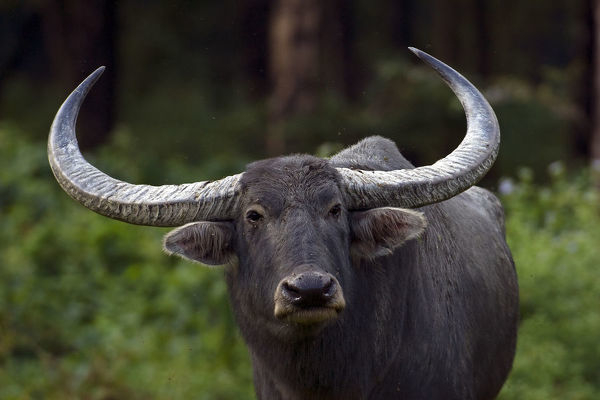
Source: Nature Picture Library Source: Kaltblut-Video -
The moose is the world's largest deer species and one of the animals with the greatest horns. Moose may be found in portions of North America, as well as Poland, Kazakhstan, and Russia, where they are known as elk. Moose, unlike most deer, live alone and only come together to mate during the mating season. Adults range in height from 4.6 to 6.9 feet tall and weigh between 441 and 1,543 pounds.
Only male moose have antlers, which are shaped like twigs and develop in a dendritic pattern. The antlers grow outward from the center of the head, curling upward and expanding outward. The antlers of a mature male moose may reach up to 83 inches in length and weigh up to 40 pounds apiece. Males may use their antlers to struggle with one another for mating rights during the breeding season.
Length: 83 inches
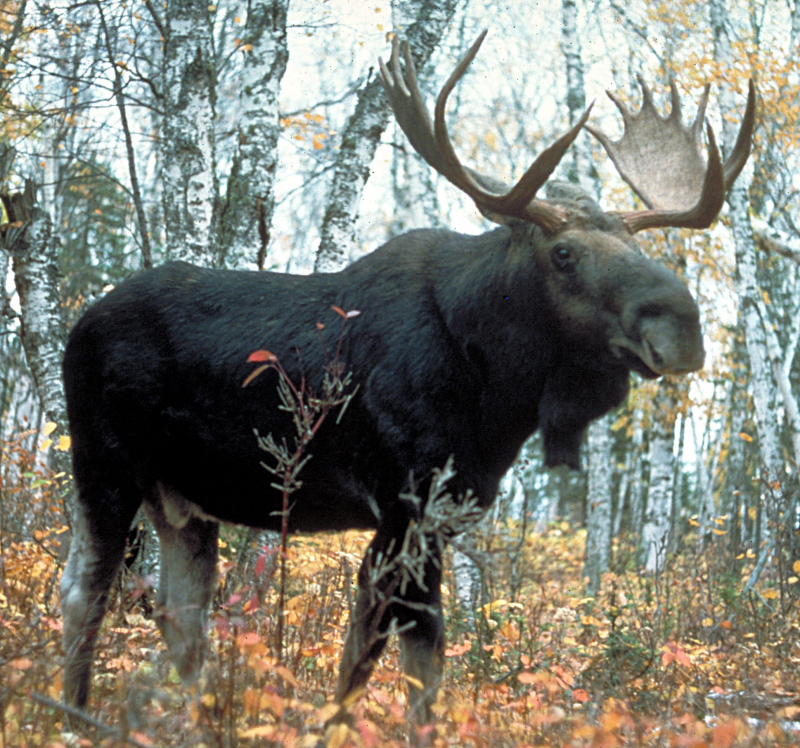
Source: Wikipedia Source: Free School -
The Greater kudu, another of the world's largest horned animals, like the bushbuck, eland, and addax, belongs to the spiral-horned antelope family. It is one of two kudu species, the smaller, lesser kudu is the other. They may be found throughout Eastern and Southern Africa, although habitat degradation and poaching pose a threat to some populations.
Greater kudus have long legs and a thin body. Their coat is brownish-gray or reddish-brown in color, with 4 to 12 white stripes running down their body. Males may grow up to 63 inches tall and weigh between 420 and 694 pounds, making them one of the biggest antelope species. The males acquire lengthy horns with two to three twists in addition to their beards. Their horns may range in length from 47-74 inches when measured along the curve.
Length: 47-74 inches
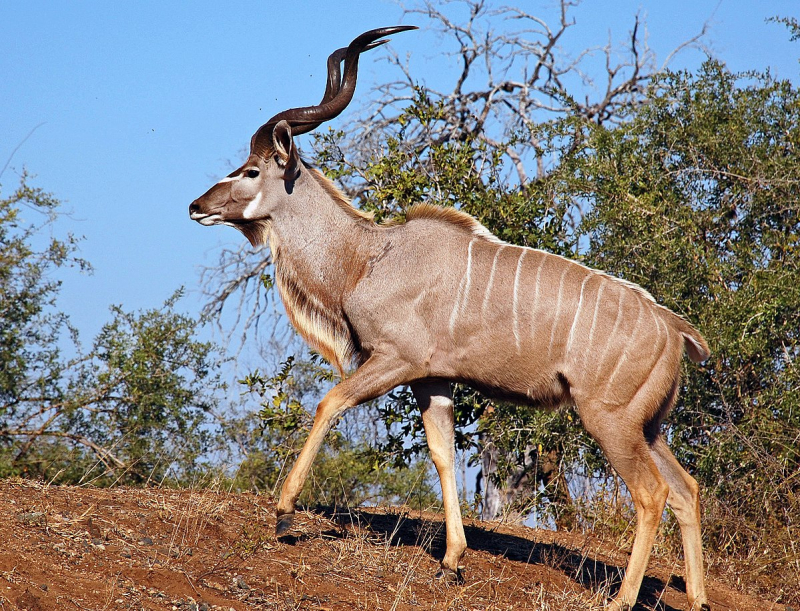
Source: Wikipedia Source: BWoodPhotography -
The markhor, sometimes known as the screwhorn goat, is a Central Asian species of wild goat. Due to traditions about them killing and devouring snakes, the Persian name markhor means "snake-killer." They reside in hilly woods and scrublands, and their food varies according to the season, ranging from grass to tree debris.
Outside of the mating season, male markhors live alone, while females and young dwell in small herds. Their coats are light brown or black in color and fluctuate in length throughout the year. They stand from 26 to 45 inches tall and weigh 71 to 243 pounds on average. Males and females both have horns, but the males' horns are substantially bigger. The horns corkscrew firmly up and outward from the head. Male horns may grow to be 63 inches long when straightened, whereas female horns are substantially shorter.
Length: 63 inches
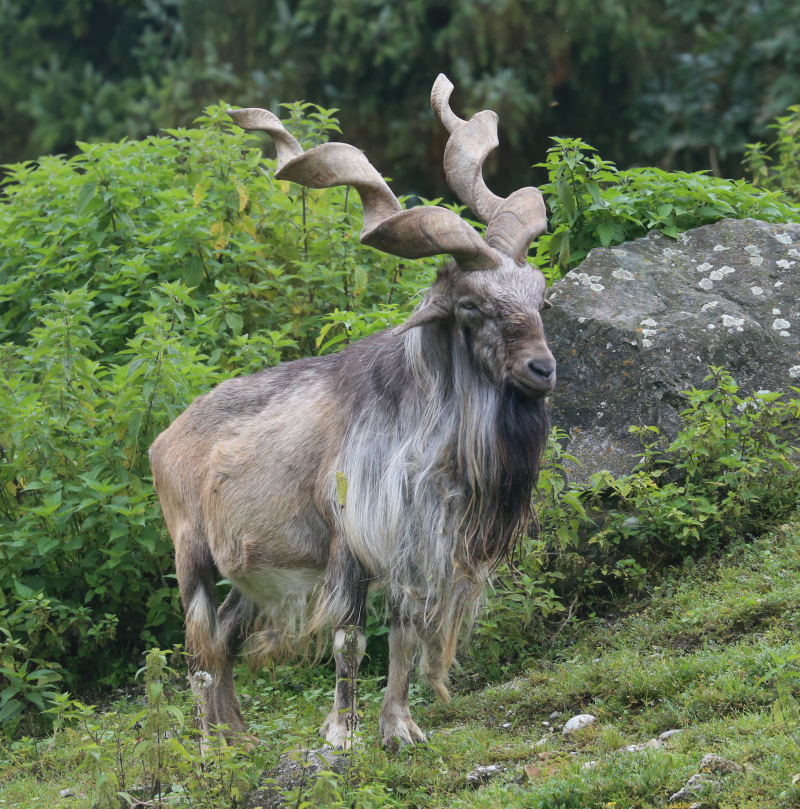
Source: Wikipedia Source: Earth Titan -
The elk, often known as the wapiti, is the second-largest deer species after the moose. They are found in North American woodlands as well as portions of Central and East Asia. Wapiti is a Shawnee and Cree term that approximately translates to "white rump." This refers to the color of their coats, which are off-white or beige from the shoulders down.
Meanwhile, their neck is covered in a thick, shaggy mane of dark brown hair that generally matches the hue of their face. Male elk may reach heights of 4 feet, 11 inches and weights of 1,300 pounds. Only male elk acquire antlers, which may grow up to one inch each day until they reach full maturity. They may grow up to 48 inches long from tip to point at their maximum size, weighing approximately 40 pounds per antler.
Length: 48 inches
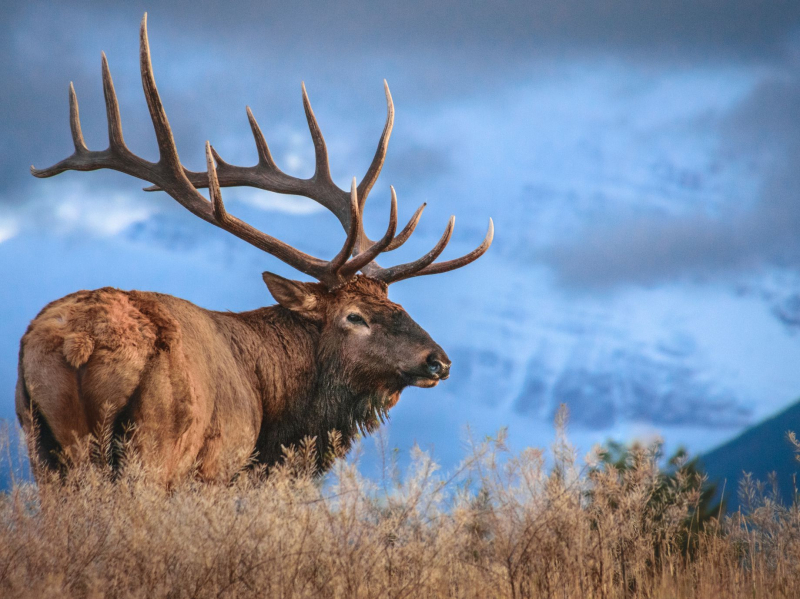
Source: Treehungger Source: National Geographic -
The scimitar oryx is one of four oryx species that may be found in Africa. The scimitar oryx, one of largest horned animals in the world, also known as the scimitar-horned oryx, was declared extinct in the wild in 2000. However, a tiny number of them remain in carefully supervised preserves and zoos across the world. Scimitar oryxes lack black facial and leg markings, and their horns bend rather than stand straight, unlike other oryxes.
They have a predominantly white or beige coat that helps them stay cool in the scorching desert heat. They may grow to be 3.3 feet tall at their tallest, with males being somewhat bigger than females. Males and females both have horns that may grow up to 47 inches long. Scimitar oryxes have radically curled horns, while being categorized as straight-horned antelopes. Their name comes from the shape of their horns, which resemble scimitars.
Length: 47 inches
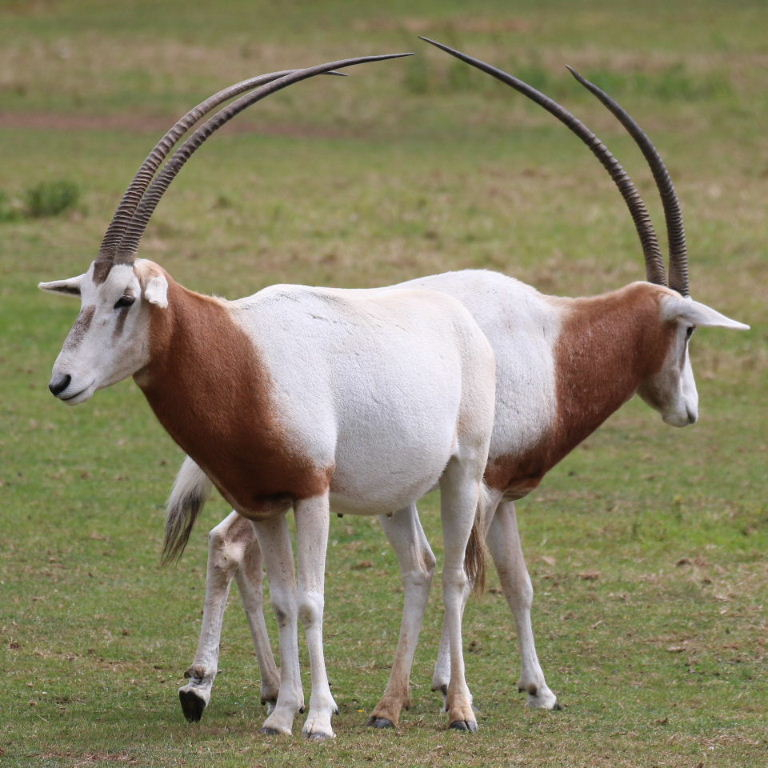
Source: Animal Photos Source: National Geographic -
The addax, also known as the white antelope or screwhorn antelope, is a spiral-horned antelope. Despite being indigenous to the Sahara Desert, owing to unregulated hunting, just a handful survive in the wild. As a result, the IUCN has classified them as Critically Endangered, and the majority of the surviving individuals currently live in zoos or preserves. Males typically stand 41 to 45 inches tall and weigh 220 to 276 pounds, while females are shorter. The color of their coat changes throughout the year, from gray-brown in the winter to white or blonde in the summer.
The addax is still on the list of the largest horned animals in the world, despite being on the verge of extinction. Both males and females develop horns, which they bend in and out with one to two loops. Male horns may grow up to 43 inches long, while female horns are normally 22 to 31 inches long.
Length: 43 inches
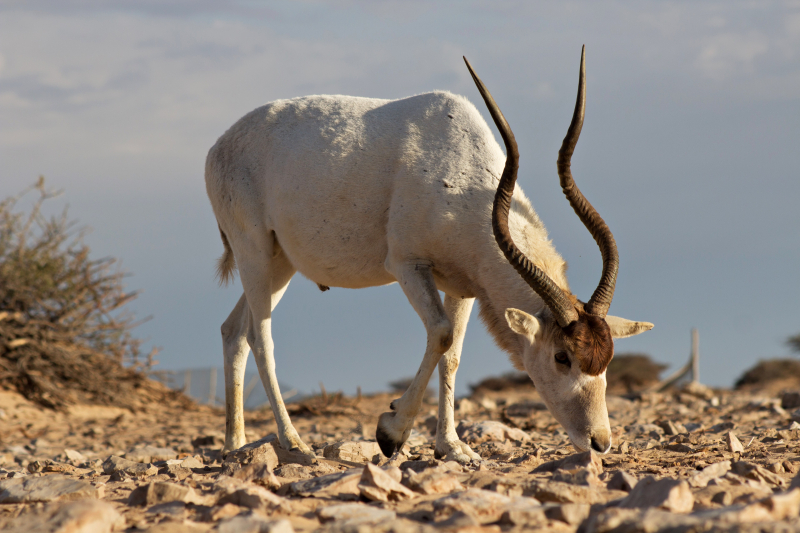
Source: Wikipedia Source: San Antonio Zoo -
Caribou, commonly known as reindeer, are in the top half of animals with the largest antlers on the planet. Although numerous populations are listed as threatened by the IUCN, they may be found in North America, northern Europe, and Siberia. The majority of caribou live in herds, and while some move, others stay put all year. Their coat is normally gray-brown in color, with a longer mane around the neck.
The boreal woodland caribou is the biggest of the caribou subspecies, with the boreal woodland caribou being the smallest. Antlers are produced by both male and female caribou, albeit the size and presence of antlers varies by subspecies. The antlers are covered in a thick velvet that comes off once they cease growing. Caribou have the greatest antlers in proportion to their body size of any deer species. Their antlers may grow up to 39 inches in length and 39 inches in width when fully grown.
Length: 39 inches
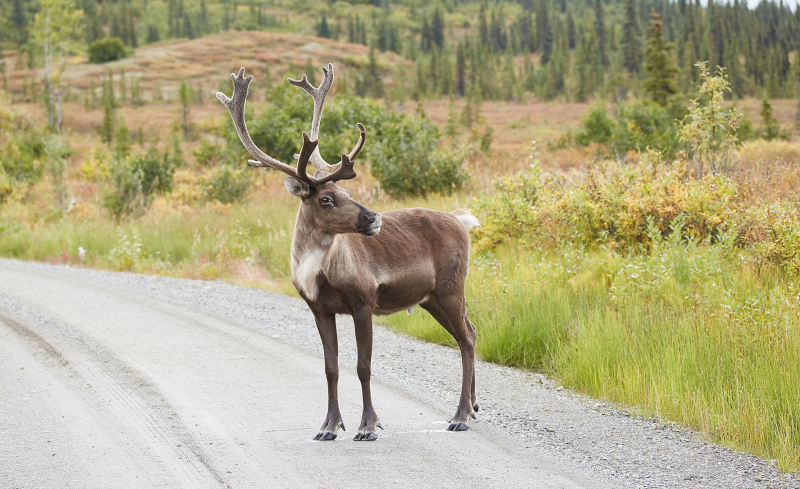
Source: David Suzuki Foundation 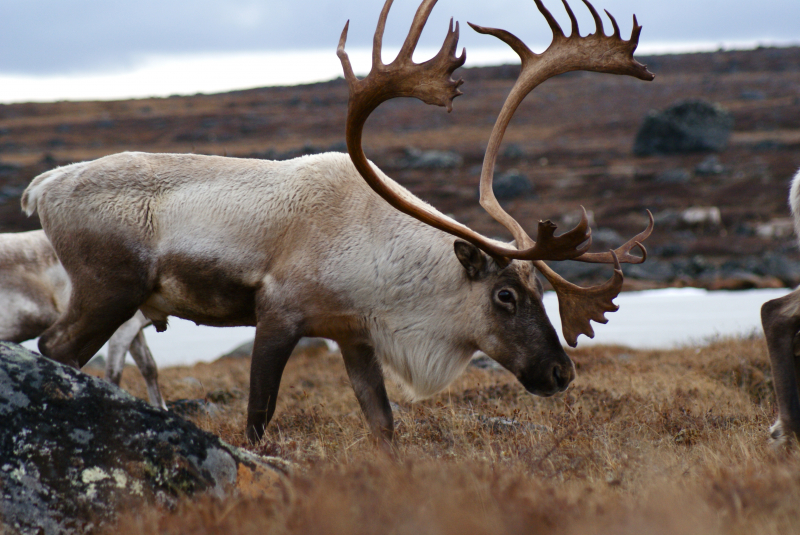
Source: Caribou Genomics -
The alpine ibex, also known as the steinbock, Capra ibex, or simply ibex, is a mountain-dwelling goat that lives in the wild. They are found across the European Alps; they were nearly extinct in the nineteenth century. While they are gregarious, they tend to gather in age and sex groupings.
Males are about 35 to 40 inches tall at the shoulder and weigh 148 to 258 pounds. Their coat is thick and brownish-gray, allowing them to thrive at high elevations. Male and female Alpine ibexes have horns, curl backwards, and have many ridges along the length of their bodies. Males, on the other hand, have significantly bigger horns. They may grow up to 39 inches long, from base to tip, at their longest. Male Alpine ibexes are among the animals with the largest horns in the world, and they are among the most prone to using them in battling over possible mates.
Length: 39 inches
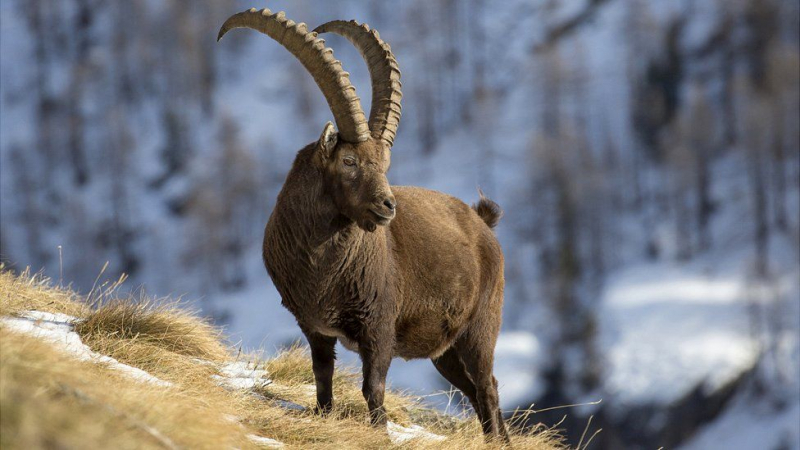
Source: BBC Source: Discovery UK -
The Ankole-Watusi cattle breed is a relatively young domestic cattle breed. The Sanga cattle from Africa are the ancestors of all Ankole-Watusis. Their name is made up of two words. They are referred to as "ankole" in Uganda, and "watusi" by the Tutsi in Burundi. The present breed, however, was developed in the 1960s via cross-breeding of Sanga cattle with a Canadian domestic variety. They are still uncommon due to their novelty, with just about 1,500 members as of 2016.
The majority of Ankole-Watusis are reddish-brown in color, with white mottling or spots. Males normally weigh between 992 and 1609 pounds, whereas girls weigh somewhat less. Their enormous horns are by far their most noticeable characteristic. Ankole-Watusis have the widest horn spread of any domestic cow breed. Individual horns may grow to be 37.5 inches long and have a spread of up to 40.7 inches from point to point.
Length: 37.5 inches
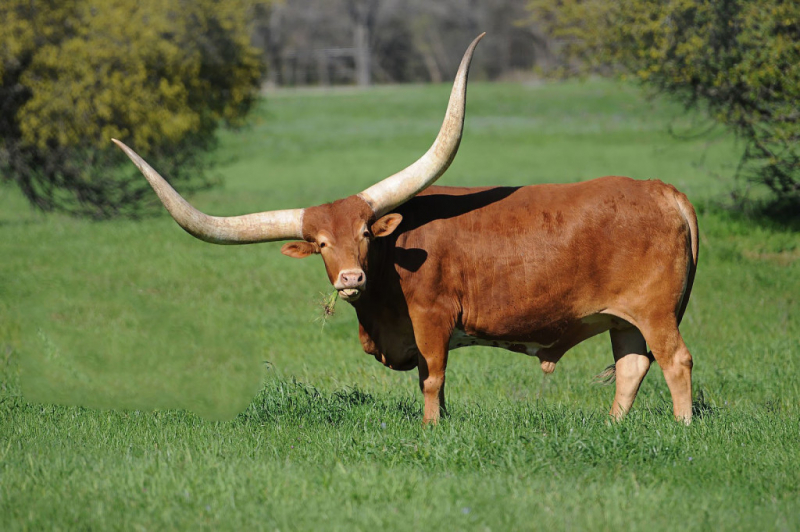
Source: Hungary Today 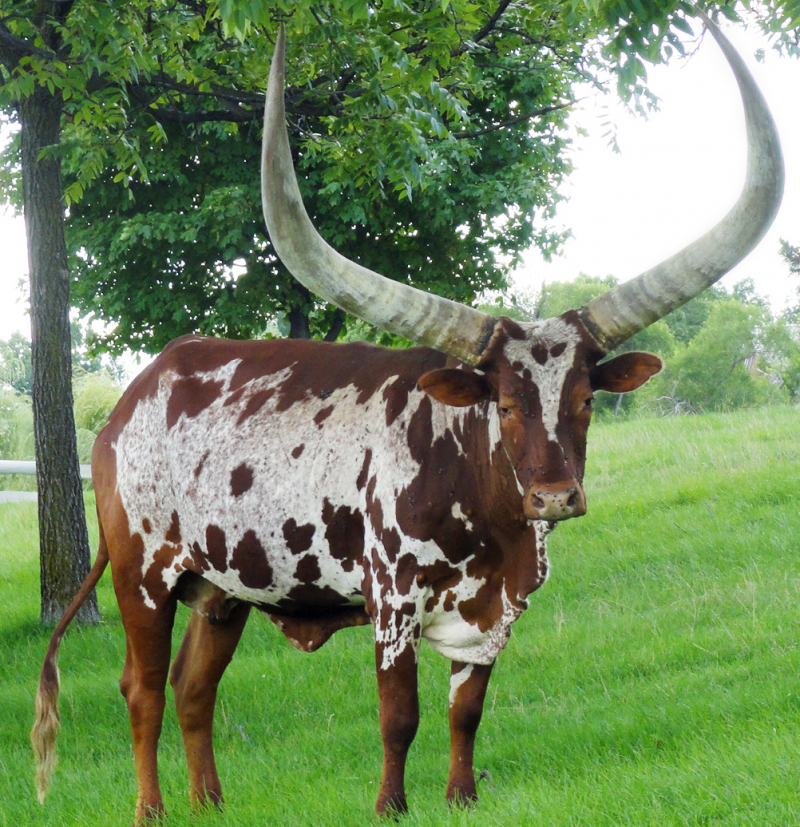
Source: Wikipedia












